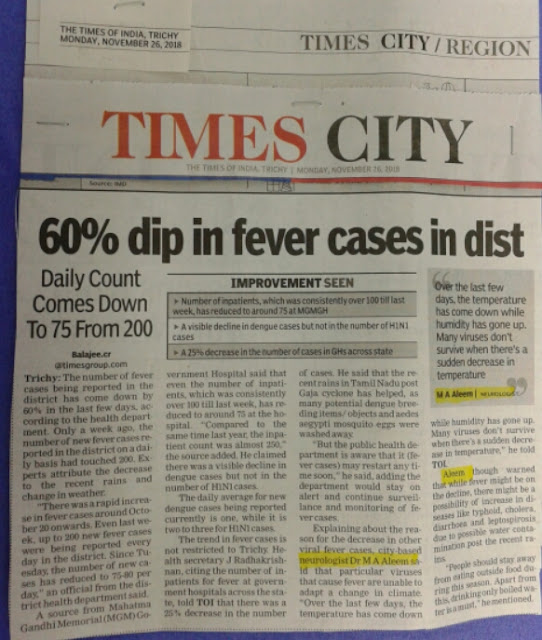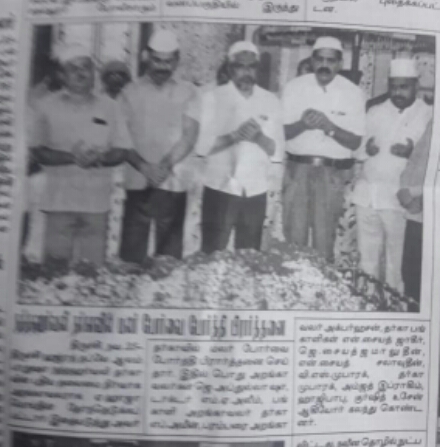Thursday, November 29, 2018
C.K.Swamy Oration on 27.11.2018 by Prof.Dr.M.A.Aleem Emeritus Professor of Neurology The Tamilnadu Dr.M G.R. Medical University on " Medical Education In Tamil -Problems and Solutions" chaired by Prof E.Soosai and Dr.P.Selvakumaram organised by Tamil Research Department at St . Joseph Autonomous College Tiruchirappalli - News in Trichy Dinamani on 30.11.2018
#SwachhBharat #SwachhSurvekshan2019 plastics blocks rain water drain on 29.11.18. Avoid #plastics in #Trichy city #Tamilnadu .Realise Citizens Responsibility&help to keep #Trichy city #Tamilnadu #PlasticFree to beat Health risks - M.A.Aleem member #Tiruchirappalli District Welfare Fund committee (#DWFC) 30.11.18
Wednesday, November 28, 2018
Tuesday, November 27, 2018
Monday, November 26, 2018
Sunday, November 25, 2018
India--the World Capital for Diabetes -Aleem M A., Hakkim A M. BMJ 2018;363:k4921
BMJ
Editor's Choice
The growing problem of diabetes
BMJ 2018; 363 doi: https://doi.org/10.1136/bmj.k4921 (Published 22 November 2018)
Cite this as: BMJ 2018;363:k4921
Rapid response
Re: The growing problem of diabetes
India--the World Capital for Diabetes
India currently represents more than 50 percent of the world’s diabetes burden, with an estimated 72 million cases in 2017, a figure expected to almost double to 134 million by 2025.
This presents a serious public health challenge to India facing a future of high population growth, and the Government of India is attempting to provide Prime Minister Modi 's Ayushman Bharat free health insurance to half a billion people.
In India, lifestyle changes such as inactivity and the excessive consumption of high-calorie foods, both changes that accompany economic development, exacerbate diabetes risk factors.
In India, because of a lack of awareness of diabetes symptoms and risk factors compared to those in higher socio-economic groups, the poor have greater difficulty in managing the disease.
Competing interests: No competing interests
24 November 2018
M.A. Aleem
Emeritus Professor of Neurology* Visiting Specialist in Neurology** Consultant Neurologist***
A.M Hakkim
The Tamilnadu Dr.M.G.R. Medical University* Dhanalakshami Srinivasan Medical College Hospital** ABC Hospital***
Chennai 600032* Perambalur 621212** Trichy 620018*** Tamilnadu India
Dr.M. A Aleem
Saturday, November 24, 2018
Hats off to Tamilnadu Government for war footing relief measures towards Gaja disasters - M.A.Aleem Neurologist Trichy Tamilnadu India
Hats off to Tamilnadu Government for war footing relief measures towards Gaja disasters
-Prof.Dr.M.A.Aleem M.D.D.M (Neuro) Trained at Institute of Neurology Queens Square University College of London UK
Life Member
Tiruchirappalli District Welfare Fund Committee
Trustee (அறங்காவலர்)
Natharwali Dargah Trichy
Emeritus Professor of Neurology
The Tamilnadu Dr.M.G.R. Medical University
Past President
Tamilnadu Pondycherry Association of Neurologists
Former Dean Vice-Principal
KAPV Govt. Medical College and MGM Govt. Hospital.
Fromer HOD and Professor of Neurology Senior Neurology civil surgeon KAPVGMC and
MGM Govt. Hospital
Secretary
Neurologist Association of
Tiruchirappalli
Consultant Neurologist and Epileptologist
ABC Hospital
Trichy 620018
Tamilnadu
India
drmaaleem@hotmail.com
Phone 9443159940
Storms regularly hit southern India between April and December.
Tamil Nadu being a coastal state is one of the most cyclone prone regions in the country.
Gaja is the second major storm to hit India's east coast in recent weeks.
When cyclone Gaja makes landfall between Cuddalore and Pamban on16.11.2018 it is the 10th cyclone to affect Tamil Nadu in the past 16 years. The total number of cyclones that have affected the state between 1891 and 2002 are 54, which is the fourth highest numberin the country after Odisha (98), Andhra Pradesh (79) and West Bengal (69). This means that while the rate of occurrence of cyclones in the Tamilnadu state between 1891 and 2002 was 0.49 per year, in between 2003 to 2018 the rate increased to 0.63 per year. The rate of occurrence has increased by almost 30 per cent.
In 2017 , cyclone Ockhi had killed 14 people in the Tamilnadu state and a year before that cyclone Vardah had killed 24 people.
The state’s action plan for climate change (SAPCC) identifies cyclones as a major concern. It says that Tamil Nadu has experienced devastating effects of storm surges due to cyclones 30 times between 1900 and 2004. The affected districts were Chennai, Cuddalore, Nagapattinam, Thanjavur, Ramanthapuram and Kanyakumari.
For cyclone Gaja, the India Meteorological Department (IMD) has issued a storm surge warning of as high as one metre which “could inundate low lying areas of Nagapattinam, Thanjavur, Pudukkottai and Ramanathapuram districts of Tamil Nadu and Karaikal district of Puducherry at the time of landfall”.
The government of Tamilnadu has taken multiple steps under the state action plan for climate change to mitigate the risk from cyclones. “It has established emergency control centres, one at state level and six in coastal districts to disseminate timely disaster information. The state government has planned to upgrade these already established emergency control centres and establish seven more such centres in the remaining seven costal districts,” states the SAPCC report.
Tamil Nadu state government has estimated that the cyclone Gaja 2018 on 16 November at speed of 120 kmph has uprooted over 170,000 trees and damaged about 117,000 houses.
About 177,500 people are staying in 351 relief camps in the cyclone-affected areas.
Farmers have seen acres of their coconut farms and banana plantations ruined. The impact of the cyclone also damaged electricity transformers and power lines, cutting off electricity in several districts.
According to figures released by Tamil Nadu Generation and Distribution Corporation (TANGEDCO), over one lakh electrical poles which include 22,680 high tension poles and 63,156 low tension poles have been damaged in Tamil Nadu. A survey has been conducted in Nagapattinam, Pudukottai, Thanjavur, Tiruvarur, Dindugal, Ramnad, Sivagana, Theni and Cuddalore. Most of the damage to the poles was witnessed in Pudukottai. A total of 84,836 poles have been affected. Meanwhile, 1,152 km of high tension lines and 3,087 km of low tension lines were damaged due to the cyclonic winds. A total of 841 distribution transformers have been damaged.
Due to the cyclone Gaje that crossed the Tamil Nadu coast between Nagapattinam and Vedaranyam districts between 12.30 a.m. and 2.30 a.m. on 16.11.2018 Friday,
the death toll due to cyclone Gaja, has increased to 33, which include 20 men, 11 women, and 2 children.
About 70 livestock and several goats, poultry and deer have also died due to the Gaja .
Strong winds brought down thousands of trees and destroyed homes, forcing hundreds of thousands of people to flee to shelters.
The head of the Tamilnadu state government, Edappadi Palaniswami, said most deaths were caused by flooding, collapsing houses and electrocution. He has announced the compensation of Ten lakhs ($14,000) each to the families of victims.
Hundreds of emergency workers have been used to restore roads and power cables, and a navy helicopter and two ships have joined the relief efforts along with many volunteers and non governmental organisations.
-M.A.Aleem
Tiruchi
Friday, November 23, 2018
Thursday, November 22, 2018
OZONE ' S "Kalam Award For Quality Of Life Improvement " with Shield Certificate and Medal To Dr.M.A.Aleem Past President of Tamilnadu Pondicherry Association of Neurologist received the award from Dr. K.Meena Former Vice Chancellor of Trichy Bharadhidasan university in the presence of Dr. K. Govindaraju Chairmen of OZONE on 18.11.2018 news in Deccan Chronicle and Daily Thanti on 19.11.2018
Wednesday, November 21, 2018
Tuesday, November 20, 2018
Monday, November 19, 2018
OZONE ' S "Kalam Award For Quality Of Life Improvement " with Shield Certificate and Medal To Dr.M.A.Aleem Past President of Tamilnadu Pondicherry Association of Neurologist received the award from Dr. K.Meena Former Vice Chancellor of Trichy Bharadhidasan university in the presence of Dr. K. Govindaraju Chairmen of OZONE on 18.11.2018
Sunday, November 18, 2018
OZONE ' S "Kalam Award For Quality Of Life Improvement " To Dr.M.A.Aleem Past President of Tamilnadu Pondicherry Association of Neurologist received the award from Dr. K.Meena Former Vice Chancellor of Trichy Bharadhidasan university in the presence of Dr. K. Govindaraju Chairmen of OZONE on 18.11.2018
#Gaja strom 2018 16.11.2018 Tiruchirappalli district Thuvarankurichi Tamilnadu India severely affected . EO Shaul Hameed and district collector K. Rajamani IAS have done a great job Electricity restored in 30 hours. water suppy made available in shortrst period fallen trees cleared at once .so people of thuvarankurichi is free to have their day today activities without problems due to Gaja strom thank you sir M.A.Aleem Trichy District Welfare Fund Committee 16.11.2018
Saturday, November 17, 2018
Friday, November 16, 2018
Screening with software to confirm appropriate prescription . Aleem M A. BMJ 2018;363:k4688
BMJ
Editorials
Tackling potentially inappropriate prescribing
BMJ 2018; 363 doi: https://doi.org/10.1136/bmj.k4688 (Published 14 November 2018)
Cite this as: BMJ 2018;363:k4688
Rapid response
Re:Tackling potentially inappropriate prescribing
Screening with software to confirm appropriate prescription
To find out the appropriate prescription for a disease state, the following methods can be useful
1. Use of software to find out the proper drug prescriptions for a particular disease condition by scanning the prescription sheets at dispensing.
2. For this, proper diagnosis and other comorbid conditions must be in prescription sheets.
3. Writing the generic name of the drug in the prescription sheet can also be useful in assessing the appropriate drug prescription for the particular disease.
This type of information in prescription sheets for screening with the help of software can be very useful to find the appropriate prescribing in medical practice.
Competing interests: No competing interests
16 November 2018
M.A. Aleem
Emeritus Professor of Neurology* Visiting specialist in Neurology** Neurologist***
The Tamilnadu Dr.M.G.R. Medical University* Dhanalakshmi Srinivasan Medical college ** ABC Hospital***
Chennai 600032* Perambaur 621212** Trichy 620018*** Tamilnadu India
M.A.Aleem




















































